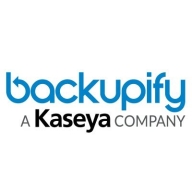

Nasuni and Backupify compete in the data storage and backup sector. Nasuni is considered more robust in pricing and support, whereas Backupify is favored for its feature set, offering value worth its price.
Features: Nasuni provides scalable storage and synchronization across global offices with strong security measures. It ensures comprehensive access control and real-time data availability. Backupify offers automated backup functionality and seamless Google Workspace integration, delivering reliable cloud backup and recovery options.
Ease of Deployment and Customer Service: Nasuni ensures a straightforward deployment with extensive support for complex infrastructures, accommodating diverse business needs. Backupify allows easy installation for quick integration within Google Workspace, supported by responsive customer service.
Pricing and ROI: Nasuni involves a higher initial setup cost but yields a solid return on investment through long-term efficiency and scalability. Backupify offers more economical options aimed at small to medium-sized businesses, providing ROI that aligns with its cloud-focused features.
| Product | Market Share (%) |
|---|---|
| Nasuni | 1.1% |
| Backupify Google Workspace Backup | 0.4% |
| Other | 98.5% |

| Company Size | Count |
|---|---|
| Small Business | 3 |
| Midsize Enterprise | 8 |
| Large Enterprise | 24 |
Backupify Google Workspace Backup provides essential data protection for Google Workspace users, ensuring continuity and security through comprehensive backup and restoration capabilities.
Designed to meet the needs of businesses relying on Google Workspace, Backupify Google Workspace Backup offers automated data protection, minimizing risks of data loss and ensuring compliance with industry standards. It supports seamless restoration functionalities, making it easier for IT administrators to manage and recover data efficiently, while also providing secure storage options to preserve data integrity.
What are the key features of Backupify Google Workspace Backup?In the healthcare sector, Backupify Google Workspace Backup ensures the protection of patient records, while in finance, it secures sensitive financial data, meeting specific industry compliance requirements. Schools use it to safeguard academic information, ensuring educational continuity and data availability.
Nasuni is a file data services enterprise focused on assisting firms with their digital transformation, global expansion, and information awareness. The Nasuni File Data Platform is a suite of cloud-based services designed to enhance user productivity, ensure business continuity, provide data intelligence, offer cloud options, and simplify global infrastructure. This platform and its auxiliary services are projected to replace conventional file infrastructure such as network attached storage (NAS), backup, and Disaster Recovery (DR), with an expandable cloud-scale solution. By storing file data in scalable cloud object storage from multiple providers, Nasuni positions itself as a cloud-native alternative for traditional NAS and file server infrastructure. Based in Boston, Massachusetts, USA, Nasuni serves sectors like manufacturing, construction, technology, oil and gas, financial services, and public sector worldwide, offering its services in more than 70 countries.
James J., IT Manager at a marketing services firm, says Nasuni’s management dashboard is helpful because he's able to view all of the different filers at once rather than check each one of them individually. He values the software’s security, reliability, good performance, helpful alerting, and responsive support.
According to a Server Engineering Services Lead at a mining and metals company, Nasuni offers good OR and DR capabilities, performs well, offers data security, and continuous file versioning helps recover from hardware failures.
The Managing Director of IT at a construction company appreciates Nasuni because it eliminates a lot of work that was previously done when managing backing up and restoring data files.
We monitor all Cloud Backup reviews to prevent fraudulent reviews and keep review quality high. We do not post reviews by company employees or direct competitors. We validate each review for authenticity via cross-reference with LinkedIn, and personal follow-up with the reviewer when necessary.